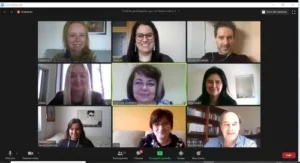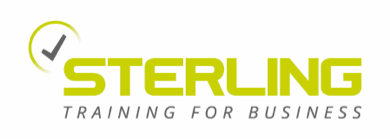Make your virtual team meetings better than ever with 5 easy steps, based on our learner-centred training techniques, and change the dynamics of your online meetings forever…

- Set a clear purpose and outcomes.
- Videos and mics ON.
- Use activities to change the dynamics.
- Check everyone understands.
- Get commitment to actions.
A quick look at the work calendar and there it is … the virtual, weekly team meeting. Nobody, NOBODY puts their video or mic on any more and you have a sneaky suspicion that people catch up on their emails and WhatsApps. As long as they’ve had a quick peek at ‘the agenda’ (quick list in the calendar invitation), you’re happy. Its 45-minutes of everyone’s time which has to be endured, it’s no easier for you.
Managers and teams are missing out on the massive benefits available from regular team meetings, which should just be about keeping everyone updated. How about using them for:
- Building empowerment and ownership;
- Team cohesion;
- Communicating and sharing ideas;
- Problem solving
Here are some simple tweaks, based on our learner-centred training techniques, to change the dynamics of your online meeting in 5 easy steps.
- Set a clear purpose and outcomes.
First of all, think carefully as to why the meeting is being held and what the expected outcomes are. Hopefully, the reason is to share knowledge/ important information and build team cohesion. If it’s in the calendar because you have always had a team meeting at that time, think again.
Communicate clearly who needs to be there and what they’ll get out of it.
Once you’ve set the who and the what, a slightly provocative approach could be to say that the meetings are optional. This way, the people who attend probably want to be there and, then it’s your duty to make it worthwhile for them. It does mean that clear notes and outcomes of the meeting need to be distributed afterwards to keep the team informed. If you and your team haven’t achieved anything by attending, it’s a very expensive waste of 45 minutes!
2. Videos and mics ON.
Who is ‘The Legend”? Would anyone recognise them if they came into the building? What do they do? Building team cohesion starts with knowing who is in the team as well as what they look like, so they are colleagues not strangers. Some teams are spread around the country or even the world and you need to maximise the opportunities for encouraging people to feel part of the team need to be maximised.
Observing facial expressions and body language are vital parts of communication and this is even more important on virtual platforms. You need to see your team’s reactions to key information and it’s a great way to see if they’re engaged and looking well.
Having the mic on, ready to respond or ask a question is important. It’s amazing how slow people are to find the mic button and actually miss (maybe avoid) the opportunity to contribute just because they have put themselves on mute.
*Do apply common sense. I had someone who couldn’t put his video on for a meeting because he was working at a forensic crime scene…we all WANTED him to turn it on, but for obvious reasons he couldn’t. However, he did get extra points for attending the meeting and actively participating, despite being under extreme pressure!

3. Use activities to change the dynamics
We’ve all experienced webinars where you have to keep fidgeting to stay focussed or add fatuous unnecessary comments in the Q & A box just to stay awake (and demonstrate that you are actually ‘there’). Virtual team meetings can be much the same so planning how to get the team to engage is vital.
At Sterling, our approach to training delivery and meetings is ‘learner/participant-centred’. Did I hear someone say, “so what?”, well I’ll tell you what. It engages people; it builds rapport; it encourages thinking and creativity; it motivates people to participate; it encourages reflection on learning and achievements and it encourages collaboration. Mentally (and physically) active participation enhances learning and outcomes.
So, if you have the wonderful faces of your team in front of you; this will enhance communication, attention and participation in itself, so exploit that as much as you can. As with training, there are better outcomes when participants are involved.
I hate to tell you this, but it’s NOT all about YOU
Just because you are the meeting lead doesn’t mean that it’s your voice that has to dominate. Take the pressure off yourself and encourage your team to contribute and lead certain elements of the meeting (this is why there needs to be some sort of agenda). This reinforces that it is a team meeting and encourages collaboration and ownership by all.
- Make use of the tools that virtual platforms like Zoom have, and encourage people to annotate slides or whiteboards, contribute to documents or mind maps, use the chat box…oh yes, and actually speak!
- Give the less confident a voice by using Breakout Rooms to actively work on ideas or discuss possible causes and solutions for work issues. This will give those folk who are reluctant to speak up in larger groups an opportunity to share their thoughts. You can then bring all their outcomes to the main room and contribute to the wider discussion.
- In pairs or small groups – ask the participants to create a list of the three top points they are taking away from the meeting and why. Then as a group (or choose a speaker) feedback to the main group. This will be a helpful checker for the minute taker as well as an opportunity for the lead to determine whether the message has been received and understood correctly.
4. Check everyone understands
If you tell the team stuff and then saying, ‘got that?’ or ‘everyone understand?’ the answer’s usually going to be ‘yes’ – those who don’t know will assume that everyone else knows so won’t embarrass themselves; those who think they know will give the impression of ‘yes’, and those who weren’t really listening (they were actually updating their Fantasy Football team at the time) will say ‘yes’. If they don’t have their cameras on, you can’t tell, anyway…
So, you need to check that people have really understood and can use the information accurately and effectively for action. At Sterling we are constantly concept-checking new words, expressions, topics etc. Try…
- Asking powerful TED and open questions, such as “So, can someone please give me an example of an ‘allowable expense’?”, then take their answer and ask someone else if they agree. If no one comes forward, nominate someone to answer. “So, Trevor, please tell us what WOMM is and why we are introducing it.” Nominating someone can be scary and you need to judge your audience. However, if Trevor has already confidently told you he understood/knew what WOMM is, it shouldn’t be a problem.
- Using Chat more effectively – If you DON’T want to nominate one person but you DO want to check individuals have understood, get your team to put their answers in the Chat box. It’s always interesting to see the variations and gain group consensus on what the correct meaning is, by discussing their contributions.
- In pairs or small groups – create a list of the three top points they are taking away from the meeting and why. Then as a group (or choose a speaker) feedback to the main group. This will be a helpful checker for the minute taker as well as an opportunity for the lead to determine whether the message has been received and understood correctly.
 Checking that everyone has the same understanding of the point under discussion and clarifying terminology or acronyms, means that you can be sure that everyone goes away with the same understanding of what was discussed and decided and can act without getting it wrong or further clarification. They will feel challenged, but they’ll get used to it.
Checking that everyone has the same understanding of the point under discussion and clarifying terminology or acronyms, means that you can be sure that everyone goes away with the same understanding of what was discussed and decided and can act without getting it wrong or further clarification. They will feel challenged, but they’ll get used to it.
5. Gain commitment to actions
How many meetings have you been to where no actions were taken away, no one had bothered to do theirs, or both? Wouldn’t it be great to be confident that everyone left the meeting owning their actions and committing to complete them by a deadline. But how?
Ask everyone for a re-cap of actions at the end, starting with you. “If we could please go around the room and cross-check the actions we’re each taking away and by when we’ll do them…I’ll start.”
At the beginning of the next meeting, ask them to update everyone on their actions. If anyone doesn’t come forward that was given an action last time, you can pick them up by name and ask for an update. If they haven’t done it, do the same at the next followed by a catch-up at
Depending on the size of the team and the personalities within it, it might take a while to turn the ship. But they will soon learn that this isn’t going away, and as their leader you are engendering (and role-modelling) ownership and responsibility.
Build ownership and accountability through a collaborative atmosphere and then team meetings can become something that people look forward to, rather than tolerate. Drive the achievement of your team and organisation’s targets and make your team meetings a truly effective use of everyone’s time. Who knows, you may even find out who ‘The Legend’ actually is, too!
So, give some of these a try and let us know how you get on! Better still, check out our leadership and management courses for more ideas on how to develop yourself to be the most effective, engaging manager you can possibly be.







